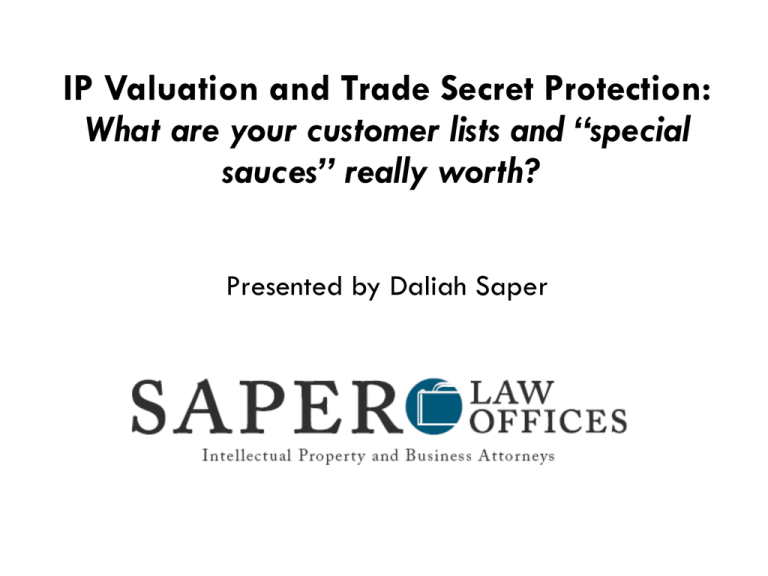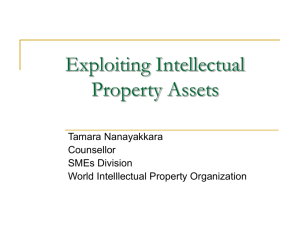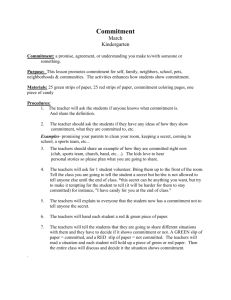September Saper Law Seminar: IP Valuation and Trade Secret
advertisement

IP Valuation and Trade Secret Protection: What are your customer lists and “special sauces” really worth? Presented by Daliah Saper Introduction About Saper Law: Saper Law is an intellectual property and business law firm with significant transactional and both federal and state litigation experience. We primarily specialize in the following areas of law: Trademarks Defamation Copyrights IP Trade Secrets Corporate Internet and Cyber Space Entertainment Licensing Advertising Media Sponsorship and Advertising Agreements Intellectual Property 101 Identify Register Maintain/Protect Exploit Step 1: Identify Identify what intellectual property your business possesses. Types of Intellectual Property Copyright Patent Trademark/Servicemark Trade Secret Copyright Applies to any work that is an original work of authorship fixed in a tangible medium of expression. Copyright owners enjoy the exclusive right to make copies of the work, distribute copies of the work to the public, prepare derivative works, perform the work publicly, and display the work publicly. Copyright - Software What is copyrightable in Software? Source Code Look and feel of the interface Websites can be copyrighted too You can not copyright FACTS, or LISTS OF GENERAL INFORMATION, TRADEMARKS, IDEAS (Patents) A note about Open Source Don’t use Open Source software to create new software or modify your current software without reading the license. You may find yourself in a situation where you can not monetize your copyright…. Patent You get a patent if you invent something that is a: New (no prior art) Useful (has a function or purpose) and Non-Obvious….(everyone didn’t already think of this) Process or Program Machine Article of manufacture Composition of matter (biological patents) If you get a patent you earned the exclusive right to prevent or exclude others from making, using, selling, offering to sell or importing the invention. Note, it’s a right to “exclude”—not a right to use. Trademark/Servicemark A trademark is a source identifier. It can be a Word Name Tagline Symbol/logo Domain Name Even smell or sound! When a trademark is used in relation to services rather than products, it may sometimes be called a Service Mark. To get a trademark, you need to USE IT in COMMERCE. The law is primarily intended to protect the consumer from confusion. Trade Secret A trade secret is information that: Is not generally known to the public; Confers some sort of economic benefit on its holder Is the subject of reasonable efforts to maintain its secrecy. A trade secret is information that is valuable to the owner as a secret, and therefore must be protected as such. If the owner’s competitors generally know or could easily discover the secret information, the owner could lose his competitive edge. Trade Secrets - Importance Why are they important? More and more companies are relying on trade secrets rather than other forms of IP. Many trade secrets can be patented or copyrighted too, but those IP forms require disclosure and only give rights for limited durations. Trade secrets endure as long as the secret is maintained. Trade secret examples: Coca-Cola’s recipe; Google’s search algorithm. Trade Secrets - Why? Why trade secret over other IP methods: Advantages: Protection can endure indefinitely, so long as secrecy is maintained and secret continues to provide a competitive advantage. Do not have to share your knowledge with competitors. Disadvantages: Once information becomes public, protection is lost forever. Remedies are more limited than patent remedies. Requires continuous effort to maintain secrecy. ACTION ITEM Look at your business and IDENTIFY what …. Copyrights Patents Trademarks and/or Trade Secrets ….your business owns. Step 2: Register Yay, I have IP! Now what? Take Steps to REGISTER Your Work Copyright: www.copyright.gov Patent: www.uspto.gov Trademark: www.uspto.gov No registration for trade secrets Note: you may register your copywritten code as a trade secret by redacting important portions of it. Step 3: Maintain and Protect Registration is not enough. You need to Maintain and Protect your IP portfolio. Maintain and Protect - Copyright Once you register, you don’t have to worry about renewal fees or loss by abandonment. However, you need to make sure you took the proper steps to own the copyright. Maintain and Protect - Copyright Copyright Work Made for Hire Contracts are crucial Make sure you license your rights—don’t assign your rights away! (We’ll discuss licensing and assignment in more detail later.) Maintain and Protect - Trademark File periodic affidavits and fees Ways to lose protection: Abandonment—ie, make sure you keep USING your trademark. Improper licensing or assignment (lack of adequate quality control or supervision by TM owner) Genericide - prevent TM from becoming generic---ie XEROX, or BAND-AID Maintain and Protect - Patent Before Patent is Issued: Don’t disclose your invention or offer it for sale unless you have taken measures to file at least a provisional patent. Talk to your patent attorney about Prior Art. Maintain and Protect - Patent After Patent is Issued: Pay Go maintenance fees after infringers asap---otherwise you may be accused of “Laches”----or sitting on your rights for too long. (That’s a defense!) Trade Secret A trade secret is information that: Is not generally known to the public; Confers some sort of economic benefit on its holder Is the subject of reasonable efforts to maintain its secrecy. A trade secret is information that is valuable to the owner as a secret, and therefore must be protected as such. If the owner’s competitors generally know or could easily discover the secret information, the owner could lose his competitive edge. Maintain and Protect - Trade Secret Reasonable means to ensure trade secret protection often includes: Non-competition agreements Non-disclosure agreements Encryption of computer files Firewalls and network security Restricting physical access Providing notice that information is a trade secret Security guards Badges for employees and visitors Example Imagine a clever software developer who writes a program that predicts the Stock Market with 99% accuracy. If he patents his software, in 20 years, everyone can create, use, and sell similar software. However, if he keeps the software a trade secret, he can control the source code indefinitely and no one will ever know how he achieved such accuracy. It is essential that he takes sufficient steps to develop a Trade Secret Protection Program for his software. Reasonable means may include confidentially agreements, ensuring limited access to source code, having password protections, and limiting the number of people with access to sensitive information Maintain and Protect - Trade Secrets Trade Secret owner has protection against Misappropriation--acquisition of the secret information by improper means. Improper means includes: Theft Bribery Misrepresentation Breach of a duty to maintain secrecy Espionage Trade Secrets - Remedies Remedies: Injunction For actual or threatened misappropriation Court-ordered actions to protect the trade secret Damages Actual loss Unjust enrichment Exemplary damages If court finds malicious or willful misappropriation, damages may be doubled. Trade Secrets - Loss of Protection Secret is disclosed Even if it was an accident. e.g., describe a trade secret to another over drinks. Reverse engineering of a product destroys protection. Unless there is an End-User Licensing Agreement (EULA) expressly prohibiting reverse engineering. Trade Secrets - Loss of Protection After a misappropriation: Delay in seeking relief Must act within 5 years of learning of the misappropriation. If the secret becomes well-known as a result of the misappropriation i.e., the owner did not contain the disclosure. Trade Secrets - Loss of Protection Using the trade secret for illegal purposes e.g., violating anti-trust laws. The trade secret enters the public domain and there is no protection. Parallel research: Another person independently creates or discovers the same secret. Not a full loss of rights; instead they have shared rights. Both people have trade secret protection. Both people have to protect the secret as well. Failure to maintain secrecy by either will destroy protection for both. General Protection/Enforcement Strategy for all IP Determine an Appropriate Protection and Enforcement Strategy Protection = Prevention: Strong Contracts, Licensing Agreements, Trade Secret Policies and solid Employment/Work-For-Hire Contracts. Enforcement: Hire Monitoring or Watch Services Send Cease and Desist or Demand Letters Litigation Final Step: Exploit The term “Exploit” in the IP world is a GOOD word: To utilize, esp. for profit; turn to practical account. to exploit a business opportunity. The key to exploiting (MAKE $$$) off of your IP is to structure your business deals properly by understanding your ownership rights. Ways to bring your IP to market: Exploit your IP independently? License it? Joint Venture? New Entity? Sell your IP all together? Each of these have different Intellectual Property ramifications. There are also different nuances when the type of IP at issue is a copyright, vs a patent, vs a trademark. Quick run down of key terms: LICENSE vs ASSIGNMENT Licensing 101 Define Licensing A licensing agreement is a partnership between an intellectual property rights owner (licensor) and another who is authorized to use such rights (licensee). The licensor still owns the intellectual property and therefore maintains control. The agreement will often require the licensee to pay a royalty or fee for the permission to use the intellectual property. It will include a whole slew of other business terms. Assignment 101 Define Assignment An assignment is the selling or transferring of IP rights to another person. Once you assign your IP rights, you can no longer control the registered IP; the assignee will have this control. Implied Licenses If you hire a freelancer but don’t get him/her to sign a work for hire agreement, you don’t own the commissioned work. At best, you will only have an Implied License to use the commissioned work. The extent of what was “implied” often becomes the basis for lengthy and costly litigation. Implied Licenses, continued. Avoiding the Headaches of Implied Licenses Agreements A should be put in writing and contain: statement identifying who owns the copyright, or if it’s a license, what the license will allow The full scope of work to be performed A warranting and indemnification provision stating that the licensor has the authority and ability to license his/its work to you. Co-Ownership/General Partnership If you start a business without clearing defining the terms of the partnership you may fight about: IP Ownership: does the Business own it? One partner? or possibly worse…… You may be Co-Owners in which case you will have to SHARE the IP even after the dissolution of your business. Co-Ownership/ General Partnership In the copyright context: In the U.S. copyright co-owners (or “joint-authors”) are TENANTS IN COMMON. Each owner holds an undivided share in the copyright. There is no right of survivorship. That means that if one coowner dies, the other co-owner doesn’t automatically get the remaining interest. The dead guy’s heirs get it. Co-Owners Rights and Responsibilities as a Co-owner Each owner has the right to license the work or sell his proportional interest in the copyright without the permission of the others. However, you are required to account to the others for profits earned from licensing. You may not unilateral take steps to effectively destroy the value of a copyright. But it is not clear what “destroy the value of a copyright” means. Organize your venture Watch out for the legal implications of choosing a Sole Proprietorship or General Partnership structure. To be shielded from personal liability, you need to form an actual entity (LLC,Corp,etc.) Engaging an IP/Licensing Attorney A good IP attorney can help you: 1. 2. 3. 4. Help you conduct an IP “Audit” Register your marks Assist you with protection and enforcement strategies. Create the proper business structure and appropriate contracts so that you don’t find yourself without any rights. Questions? Contact Info: www.saperlaw.com






